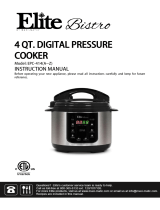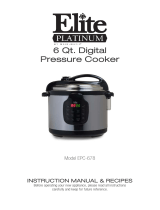
2
IMPORTANT SAFEGUARDS
When using electrical appliances, basic safety precautions should always be followed to reduce the risk of fire, electric shock, and/or injury to persons,
including the following:
1. Read all instructions.
2. This appliance is not intended for use by persons (including
children) with reduced physical, sensory, or mental capabilities,
or lack of experience and knowledge, unless they are closely
supervised and instructed concerning use of the appliance by a
person responsible for their safety.
3. Close supervision is necessary when any appliance is used by or
near children. Children should be supervised to ensure that they
do not play with the appliance.
4. Do not touch hot surfaces. Use handles or knobs. Use pot holders
when removing hot containers.
5. To protect against a risk of electrical shock, do not immerse cord,
plug, or base in water or other liquid.
6. Unplug from outlet when not in use and before cleaning. Allow to
cool before putting on or taking off parts.
7. Do not operate any appliance with a damaged supply cord or
plug, or after the appliance malfunctions or has been dropped
or damaged in any manner. Supply cord replacement and
repairs must be conducted by the manufacturer, its service
agent, or similarly qualified persons in order to avoid a hazard.
Call the provided customer service number for information on
examination, repair, or adjustment.
8. The use of accessory attachments not recommended by the
appliance manufacturer may cause injuries.
9. Do not use outdoors.
10. Do not let cord hang over edge of table or counter or touch hot
surfaces, including the stove.
11. Do not place removable pot or base on or near a hot gas or an
electric burner, or in a heated oven.
12. Extreme caution must be used when moving an appliance
containing hot oil or other hot liquids.
13. To disconnect, turn control to OFF ( ) then remove plug from wall
outlet. To unplug, grasp the plug and pull from the outlet. Never
pull from the power cord.
14. Do not use appliance for other than intended use.
15. CAUTION: To prevent damage or shock hazard, do not cook in
base. Cook only in removable pot.
16. Vessel may remain hot until after unit is turned off. Read all
instructions.
17. WARNING! Spilled food can cause serious burns. Keep appliance
and cord away from children. Never drape cord over edge of
counter, never use outlet below counter, and never use with an
extension cord.
18. Intended for countertop use only.
19. This appliance cooks under pressure. Improper use may result
in scalding injury. Make certain unit is properly closed before
operating. See “Using Pressure Cook Modes.”
20. When in pressure cook mode, do not fill the unit over 2/3 full.
When cooking foods that expand during cooking such as rice or
dried vegetables, do not fill the unit over 1/2 full. Overfilling may
cause a risk of clogging the vent pipe and developing excess
pressure. See “Pressure Cooking Modes Chart.”
21. Be aware that certain foods, such as applesauce, cranberries,
pearl barley, oatmeal or other cereals, split peas, noodles,
macaroni, rhubarb, or spaghetti can foam, froth, and sputter, and
clog the pressure release device (steam vent). These foods should
not be cooked in pressure cook mode.























